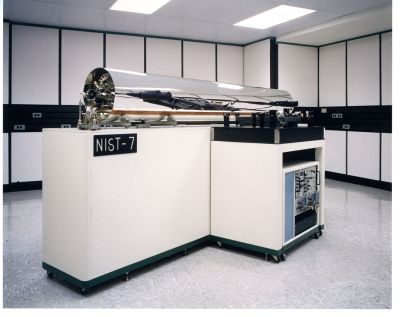At the heart of any clock is an oscillatory phenomenon that occurs at a
highly regular interval, whether this is a swinging pendulum or
voltage-driven oscillations of a quartz crystal. Mechanical and
electromechanical timepieces, however, tend to be susceptible to
temperature changes and ageing, despite their ingenious designs.
Moreover, the increasing need for more precise timing has demanded
oscillators with higher frequencies.
Optical atomic clocks make use of the frequency of electron transitions from one atomic orbital to another. They represent a revolutionary step forward in time standards, enabled by advances in the field of laser technology and quantum optics. They make use of ultrahigh, optical, oscillation frequencies. Optical atomic clocks will thus supersede Cesium (Cs)-based clocks, which 'tick' at microwave frequency, about 10 billion times per second.
In so-called lattice optical atomic clocks, cold atoms are drawn into a laser wave in form of a standing wave (optical lattice). Herein, thousands of atoms are confined simultaneously. By tuning the lattice laser light to a carefully determined wavelength, its effects on the electron transitions can be minimised. Thus, optical atomic clocks are capable of unprecedented accuracy and stability.
With EU funding of the
SOC2 project, a team of researchers is developing and operating critical components and subsystems required for ultra-precise neutral-atom lattice optical clocks suitable for transport and eventually for use in space. The researchers work with ytterbium (Yb) and strontium (Sr) atoms.
SOC2 scientists have developed the needed laser subsystems and integrated them with atomics subsystems for strontium and ytterbium into complete clock systems. For example, for the Sr-based clock, they devised compact and robust frequency stabilisation subsystems based on optical cavities, a permanent-magnet atom slower, and a very compact atom chamber. Their compact, low-power-consumption system routinely produces ultracold Sr atoms.
For the Yb-based clock, scientists developed external cavity diode lasers using narrowband interference filters that promise improved stability, compared to commonly used grating-stabilised lasers. The first prototype of the modular apparatus is fully operational. It works automatically and stably for several continuous hours of use. It has recently been successfully transported by van from the Universität Düsseldorf to the Italian metrology institute in Torino, were it is undergoing in-depth characterisation.
The SOC2 optical atomic clocks, once finalised, will represent breadboard-type demonstrators for future clocks to be used in space-based experiments, in particular for performing a more precise test of one fundamental aspect of Einstein's theory of General Relativity, the time dilation. A space clock would also be useful for delivering ultrastable frequencies across Earth.

